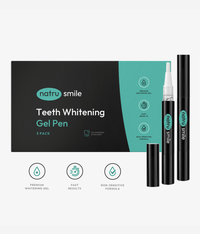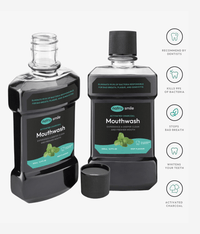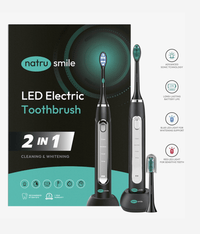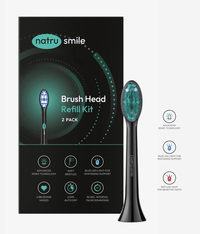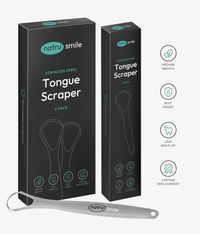
All products are certified by dental expert Dr. Greg Grillo
Dental work is often expensive and takes a long time. Those with slight imperfections or who sustain a small tooth injury (e.g., a chip) often worry that their only option is a large-scale restoration—even if their condition is relatively minor.
Fortunately, treatments like major restorations and braces are only necessary when your condition is severe. Composite bonding is a common solution to minor damage, wear, and discoloration.
In this article, we'll explore composite bonding, its uses, and what to expect if you need it for cosmetic dentistry.
What Is Composite Bonding? A Quick Look
Composite bonding—also called teeth bonding or dental bonding—is a non-invasive, cosmetic dental treatment that uses a tooth-colored resin to repair minor imperfections in a tooth's appearance.
This resin—known as composite—blends glass and plastic particles to create a durable material that can be shaped and polished to match the surrounding teeth.
Dentists apply the composite material directly to the tooth's surface, sculpting it into the desired shape before hardening it with a specialized curing light.
Composite bonding is versatile, making it an excellent choice for addressing various cosmetic concerns.
Some common reasons for using dental bonding include:
- Repairing chipped or cracked teeth
- Fixing cavities
- Filling gaps between teeth
- Improving the appearance of discolored teeth
- Reshaping uneven or misaligned teeth
- Elongating teeth for functional or aesthetic purposes
- Protecting the exposed root of a tooth due to gum recession
- Replacing silver dental fillings with natural-looking material
One of the key advantages of composite bonding is its ability to blend seamlessly with the natural tooth structure.
The composite material comes in various shades, allowing the dentist to select a color that closely matches the patient's existing teeth. This ensures a virtually undetectable repair, allowing patients to smile with confidence.
How Does Composite Bonding Work?
Composite bonding works similarly to other restorative procedures: It requires cutting away a thin layer of enamel from the affected area to make room for the composite material.
Unlike other procedures, composite bonding is minimally invasive—it builds on top of the existing tooth structure, rather than replacing or covering it.
In the case of cavities, teeth bonding works by filling the cavity with composite material and sculpting it into the desired shape.
For chipped and broken teeth, the dentist will apply several layers of composite to create a smooth surface and build out the missing area.
Understanding The Composite Bonding Procedure
Unlike most other restorative measures like veneers and crowns, composite bonding usually requires only one visit to the dentist.
In most cases, the procedure can be completed in under an hour with minimal discomfort and no anesthesia (unless used for tooth repair).
Here's a rundown of what you can expect from your composite bonding procedure:
- Consultation: During a consultation, your dentist will examine your teeth, discuss your goals, and evaluate whether or not bonding is appropriate. If you need composite bonding for an emergency restoration (e.g., to repair a chipped or broken tooth), they will fix it immediately instead of scheduling a separate appointment.
- Color selection: Your dentist will choose a composite resin shade that closely matches the color of your natural teeth.
- Tooth preparation: Before applying the composite material, your dentist will prepare the tooth surface by gently roughening it with an etching solution to create microscopic grooves. Doing this helps the bonding agent adhere more securely to the enamel.
- Application of bonding agent: The dentist will apply a thin layer of a bonding agent to the prepared tooth surface. This agent acts as an adhesive, ensuring the composite resin bonds firmly to the tooth.
- Composite resin application: Once the adhesive is in place, they will carefully apply the composite resin to the tooth, sculpting and shaping the material to achieve the desired result. This may involve repairing a chip, filling a gap, or reshaping an uneven tooth.
- Curing and hardening: Once the composite resin has been shaped, the dentist will harden the material with a curing light. This process usually takes a few minutes, and the composite resin becomes solid and durable upon hardening.
- Polishing and finishing: After the composite resin has hardened, the dentist will trim and polish the bonded area to ensure a smooth and natural-looking finish.
- Post-treatment care: After tooth bonding, you'll have to avoid staining foods and beverages, brush and floss around the bonding area twice daily, and stay away from hard or crunchy foods for a few days following your treatment.
How Long Does Composite Bonding Last?
The longevity of composite bonding varies wildly—between three and ten years. After ten years, you'll certainly need a touch-up or replacement of the composite material to keep your smile looking its best.
Several factors impact how long your composite bonding will last:
- Quality of the procedure
- Location and size of the bonding
- The amount of remaining tooth the bonding supports
- Your oral hygiene routine
- Habits and lifestyle
Patients with broken teeth will need more frequent touch-ups if their bonding covers a greater area or supports more of the tooth structure.
And those who use tobacco products, neglect their oral care routine, or eat hard foods will need to replace their composite bonding sooner.
Composite Bonding Vs. Veneers
Veneers are thin porcelain shells that are custom-made to fit over the front surface of your existing teeth.
Both treatments address cosmetic dental imperfections, but they have distinct advantages and disadvantages that may make one option more suitable for your specific needs.
Composite Bonding:
- Minimally invasive. Composite bonding requires little to no removal of the tooth's enamel, preserving the natural tooth structure.
- Cost-effective. Bonding is generally less expensive than veneers, making it a more budget-friendly option for many patients.
- Quick results. The procedure can usually be completed in a single appointment, offering immediate improvements to your smile.
- Reversible. Since bonding doesn't involve significant alterations to the tooth, the procedure is reversible if needed.
- Stain susceptibility. Composite resin can be prone to staining because it is even more porous than natural teeth.
- Less durable. Composite bonding may not be as strong as veneers, resulting in a shorter lifespan (typically 5-10 years) and potential vulnerability to chipping or breaking.
Veneers:
- Durable and long-lasting. Veneers, often made of porcelain or ceramic, are more durable than composite bonding and can last 10-20 years or longer with proper care.
- Stain-resistant. Porcelain or ceramic veneers are less susceptible to staining compared to composite bonding, maintaining their appearance for a longer period.
- Natural appearance. Veneers can provide an incredibly lifelike and natural appearance, mimicking the translucency and luster of natural teeth.
- More invasive. Veneers require the removal of a thin layer of enamel to accommodate the veneer's thickness, making the procedure irreversible.
- Higher cost. Veneers are generally more expensive than composite bonding, which may be a consideration for those on a budget.
- Longer process. The veneer procedure typically requires multiple appointments, as the veneers must be custom-fabricated in a dental laboratory before being applied to the teeth.
Composite bonding works well for those who need small, cost-effective fixes to their smile, while veneers are a better option for those seeking more extensive, long-lasting cosmetic improvements.
Composite Bonding Cost
Typically, you can expect to pay around $300 to $600 per tooth for composite bonding. However, it's essential to remember that you may need to replace the bonding every five to ten years, which will be an added cost over the long term.
There are other factors that can impact the cost of your composite bonding, including:
- Geographic location. The cost of dental procedures often varies by region, with prices generally higher in urban areas compared to rural locations.
- Dentist's experience. A dentist with more experience or specialization in cosmetic dentistry may charge higher fees for their expertise in composite bonding.
- Complexity of the treatment. If your dental issue requires a more intricate bonding procedure, the cost may be higher due to the increased time and effort needed to complete the treatment.
- Dental insurance. Some insurance plans may partially cover composite bonding if it's deemed medically necessary, such as repairing a chipped tooth. However, most insurance plans do not cover cosmetic procedures, so it's important to check your specific policy for coverage details.
Benefits Of Composite Bonding
Composite bonding offers numerous benefits to patients seeking cosmetic improvements to their smile.
In addition to its cost-effectiveness and quick results, composite bonding can:
- Lighten teeth that are discolored or stained
- Fill in spaces between teeth (diastemas)
- Reshape teeth that appear too small or large
- Improve the look of teeth with chips or cracks
- Cover worn or damaged enamel
- Correct minor misalignment of the front teeth
Composite bonding is also reversible, unlike many other dental treatments. Because it can be taken out and replaced, the procedure makes it possible for other dental procedures later on.
Drawbacks Of Composite Bonding
Like all dental treatments, composite bonding does come with some drawbacks.
Since it is reversible and minimally invasive, composite bonding isn't as strong as veneers, dental crowns, and other treatments. Because of this, composite bonding may not be suitable for large restorations or patients with extensive tooth decay.
The material used to bond teeth is not as durable as other materials used in dental procedures and may need to be replaced more often. Composite resin is strong enough to withstand normal biting forces, but it is by no means a permanent solution.
Composite bonding may also be more susceptible to staining, although many of the newer materials are less likely to discolor over time.
Even if it does not discolor, patients often find that its color does not match the color of their teeth exactly, forming a line or border between the bonded teeth and the natural teeth. It isn't noticeable in most cases, but can show through on larger restorations.
Want to learn more? These are the questions our customers ask us most.
Is Composite Bonding Good For Teeth?
Composite bonding is a safe cosmetic dental restoration method that effectively improves the look, shape, and color of teeth. It is good for teeth in the sense that it can be used to fill cavities or fix minor chips and discoloration, which could negatively impact oral health if left untreated.
Can You Drink Coffee With Composite Bonding?
Yes, you can drink coffee with composite bonding. But coffee drinkers should be aware that composite resin material can stain over time, especially when regularly exposed to dark-colored beverages like coffee, tea, or red wine.
To minimize staining and maintain the appearance of your composite bonding, consider the following tips:
- Limit consumption. Try to reduce the amount of coffee you drink or opt for lighter-colored beverages whenever possible.
- Drink through a straw. Drinking coffee through a straw can help minimize direct contact between the beverage and your bonded teeth, reducing the risk of staining.
- Rinse your mouth. After drinking coffee, rinse your mouth with water to help wash away any residual staining agents from the tooth surfaces.
- Maintain good oral hygiene. Brushing your teeth twice a day and flossing daily can help remove staining particles and keep your bonded teeth looking their best.
- Use whitening toothpaste. If your teeth become discolored over time, you can periodically use teeth whitening toothpaste to minimize the effects of drinking coffee.
Can You Brush Your Teeth After Composite Bonding?
You can (and should) brush your teeth the night following your composite bonding procedure. However, we recommend waiting to floss and using a straw when drinking hot or cold beverages for the first 24 hours after your appointment. This will help ensure that the material used in the bonding process sets correctly. You should also avoid eating sticky, hard, or crunchy foods during this time. For best results, consult with
Can You Go Back To Normal Teeth After Composite Bonding?
Composite bonding is indeed a minimally invasive and reversible procedure, as it typically requires little to no removal of the tooth's enamel. However, going back to your "normal" teeth after composite bonding might not be possible in every case, depending on the extent of tooth alteration during the bonding process.
For instance, if composite bonding was used to create a normal tooth over a chip or break, your tooth is permanently altered. Even in these cases, you can opt for a permanent option that more closely resembles normal teeth (e.g., dental crowns or porcelain veneers).
Who Is Not Suitable For Composite Bonding?
Some individuals who may not be suitable for composite bonding include:
- Extensive tooth decay or damage
- Preexisting oral health problems like gum disease
- Severe tooth misalignment that only orthodontic treatment can fix
- Heavy bite or bruxism (teeth grinding)
- Broken teeth with exposed roots
- Broken teeth where less than half of the tooth remains
Why Do My Teeth Feel Weird After Composite Bonding?
After your dentist puts composite bonding on your teeth, you can expect it to feel different—no matter what. Even if your teeth look aesthetically similar after your procedure, slight differences will be noticeable when you bite down. While you are in your dentist's chair, they will have you bite down on a black-colored paper to help identify any areas that might need extra attention.
What Can Go Wrong With Composite Bonding?
potential issues that can arise with composite bonding include:
- Staining or discoloration. Composite resin can be prone to staining, especially when exposed to dark-colored beverages or tobacco.
- Chipping or breaking. Although composite bonding is generally durable, it can chip or break if subjected to excessive force or biting on hard objects.
- De-bonding. In rare cases, the bonding may not adhere properly to the tooth, resulting in the composite material detaching or coming loose.
- Sensitivity or discomfort. Some patients may experience temporary sensitivity or discomfort in the treated tooth, especially when consuming hot or cold foods and beverages.
- Uneven appearance. Composite bonding doesn't match exactly with your tooth color and may show up as a slightly different shade.
Is Composite Bonding Worth It?
Like all restorative dental procedures, composite bonding is usually an expensive treatment. Considering its aesthetic and functional benefits, patients almost always agree that it was worth the investment. Composite bonding can give you a natural-looking smile that won't require additional maintenance, making it one of the most cost-effective cosmetic dental procedures available.
Is Composite Bonding Permanent?
Composite bonding is not a permanent solution. Unlike crowns, veneers, and implants, composite bonding is usually meant to be a temporary or fix. There are some people who use it as a permanent or semi-permanent solution, but this is only in minor cases.
Is Composite Bonding Expensive?
Compared to other procedures in cosmetic dentistry, composite bonding is relatively inexpensive. The cost will depend on the number of teeth being bonded and the complexity of the procedure. Generally, you can expect to pay anywhere from $300 to $600 per tooth. But this cost could be much higher if you live in an area with a higher cost of living.
Is Composite Bonding Covered By Insurance?
Since composite bonding is a cosmetic procedure, dental insurance plans usually don't cover it. However, some policies may cover certain types of composite bonding if it is deemed medically necessary. To prove this, you will need to provide medical records and other documentation to your insurance provider.
Is Composite Bonding Safe?
Composite bonding does not pose any significant risks to your long-term oral health. But—as with any dental procedure—there are some risks involved:
- Tooth sensitivity. Some patients may experience temporary sensitivity or discomfort in the treated tooth after the procedure.
- Allergic reaction. Although rare, some individuals may have an allergic reaction to the composite resin or bonding agents used during the procedure.
- Damage to surrounding teeth. In some cases, the process of shaping and polishing the composite material could inadvertently cause minor damage to adjacent teeth.
- Infection. If proper hygiene and sterilization protocols are not followed, there is a risk of infection during the procedure. However, this risk is minimal when working with a qualified dental professional.
Patients can mitigate these risks by selecting a reputable, experienced dentist and maintaining good oral hygiene. Regular check-ups with your dentist are also important to ensure that the composite bonding is still intact and functioning properly.
Is Composite Bonding The Same As Veneers?
Composite bonding and veneers are both cosmetic procedures, but they are different from one another in several ways. Composite bonding is a more affordable, less invasive procedure that involves applying a composite resin material directly onto the patient's tooth. Veneers are thin porcelain shells that are bonded over the entire surface of the tooth. They require shaving and removing a portion of the natural tooth, while composite bonding does not.
Can Composite Bonding Fix Crooked Teeth?
In some instances, composite bonding can help address minor cases of crooked teeth by improving their appearance and creating a more even smile. This technique, known as "dental contouring" or "cosmetic contouring," involves applying the composite material to the tooth's surface and shaping it to correct small imperfections, such as slight misalignment, gaps, or uneven edges.
Bonding is not a possible solution for severe cases of crooked teeth or significant orthodontic issues. In these situations, braces or clear aligners are the most effective treatments, as they can gradually shift the teeth into proper alignment and correct bite problems.
Can Composite Bonding Lengthen Teeth?
Composite bonding can be used to lengthen teeth, making it an effective solution for addressing issues such as short or worn-down teeth, minor chips, or uneven tooth edges. By applying the composite resin material to the tooth's surface and carefully shaping it, your dentist can create the illusion of longer teeth and improve the overall appearance of your smile.
Can Composite Bonding Break?
Composite bonding can break or chip, particularly when exposed to excessive force or biting on hard objects. While it is durable, it is still not as strong as natural tooth enamel or other restorative materials like porcelain. To minimize the risk of breakage, avoid using bonded teeth to chew on hard items, such as ice or hard candy, and address any teeth grinding habits with your dentist.
Can Composite Bonding Close Gaps?
Composite bonding can effectively close small gaps between teeth. By applying the composite resin material to the sides of the teeth adjacent to the gap, your dentist can create the appearance of closer, more evenly spaced teeth. This technique is a minimally invasive and cost-effective option for those looking to improve their smile by addressing minor spacing issues.
Can Composite Bonding Fall Off?
Although it is rare, composite bonding can sometimes fall off or become detached from the tooth. This issue can arise due to factors such as inadequate bonding between the composite material and the tooth's surface, biting on hard objects, or wear and tear over time.


